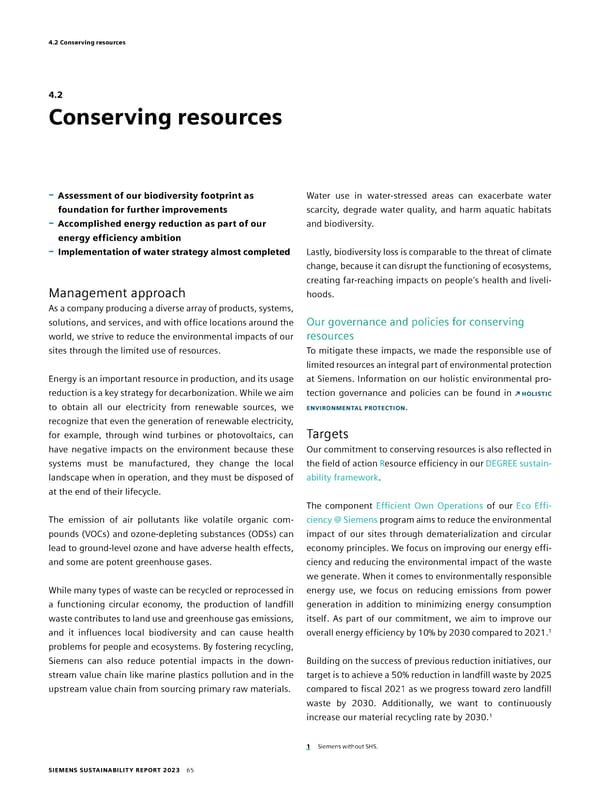4.2 Conserving resources 4.2 Conserving resources – Assessment of our biodiversity footprint as Water use in water-stressed areas can exacerbate water foundation for further improvements scarcity, degrade water quality, and harm aquatic habitats – Accomplished energy reduction as part of our and biodiversity. energy efficiency ambition – Implementation of water strategy almost completed Lastly, biodiversity loss is comparable to the threat of climate change, because it can disrupt the functioning of ecosystems, creating far-reaching impacts on people’s health and liveli- Management approach hoods. As a company producing a diverse array of products, systems, solutions, and services, and with office locations around the Our governance and policies for conserving world, we strive to reduce the environmental impacts of our resources sites through the limited use of resources. To mitigate these impacts, we made the responsible use of limited resources an integral part of environmental protection Energy is an important resource in production, and its usage at Siemens. Information on our holistic environmental pro- reduction is a key strategy for decarbonization. While we aim tection governance and policies can be found in HOLISTIC to obtain all our electricity from renewable sources, we ENVIRONMENTAL PROTECTION. recognize that even the generation of renewable electricity, for example, through wind turbines or photovoltaics, can Targets have negative impacts on the environment because these Our commitment to conserving resources is also reflected in systems must be manufactured, they change the local the field of action Resource efficiency in our DEGREE sustain- landscape when in operation, and they must be disposed of ability framework. at the end of their lifecycle. The component Efficient Own Operations of our Eco Effi- The emission of air pollutants like volatile organic com- ciency @ Siemens program aims to reduce the environmental pounds (VOCs) and ozone-depleting substances (ODSs) can impact of our sites through dematerialization and circular lead to ground-level ozone and have adverse health effects, economy principles. We focus on improving our energy effi- and some are potent greenhouse gases. ciency and reducing the environmental impact of the waste we generate. When it comes to environmentally responsible While many types of waste can be recycled or reprocessed in energy use, we focus on reducing emissions from power a functioning circular economy, the production of landfill generation in addition to minimizing energy consumption waste contributes to land use and greenhouse gas emissions, itself. As part of our commitment, we aim to improve our 1 and it influences local biodiversity and can cause health overall energy efficiency by 10% by 2030 compared to 2021. problems for people and ecosystems. By fostering recycling, Siemens can also reduce potential impacts in the down- Building on the success of previous reduction initiatives, our stream value chain like marine plastics pollution and in the target is to achieve a 50% reduction in landfill waste by 2025 upstream value chain from sourcing primary raw materials. compared to fiscal 2021 as we progress toward zero landfill waste by 2030. Additionally, we want to continuously increase our material recycling rate by 2030.1 1 Siemens without SHS. SIEMENS SUSTAINABILITY REPORT 2023 65
 Sustainability Report Page 64 Page 66
Sustainability Report Page 64 Page 66